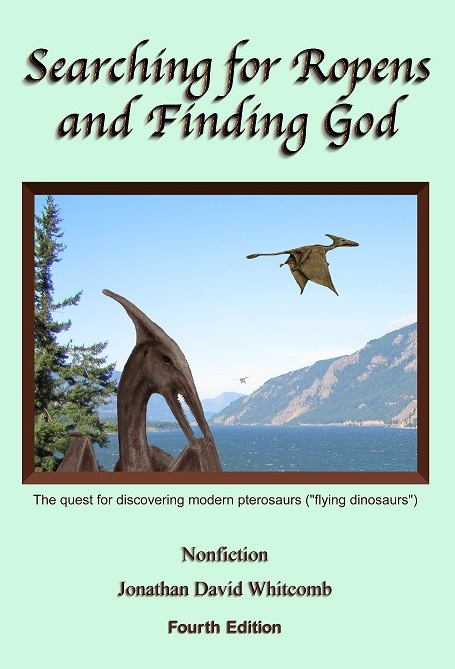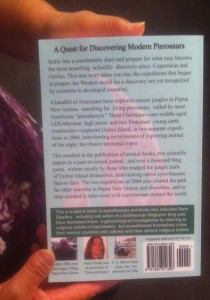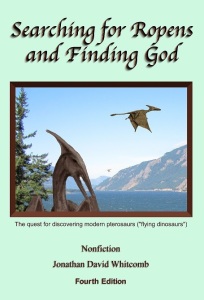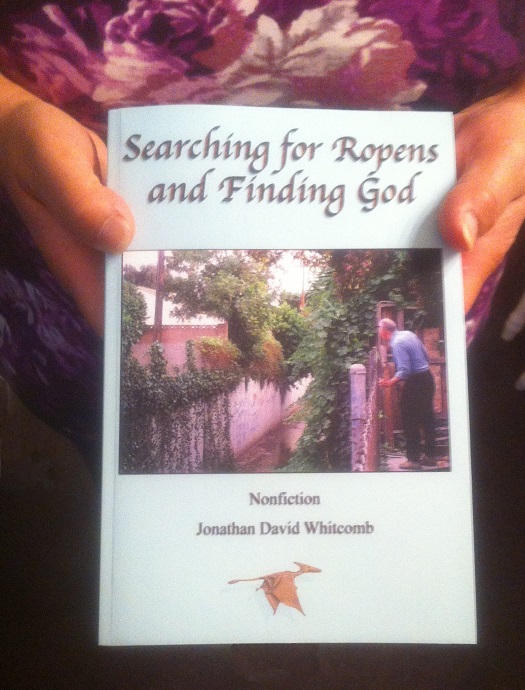I do not insist that others accept my opinions about various concepts of biological evolution, before we can communicate about modern pterosaurs. In the most recent edition of my first book (Searching for Ropens and Finding God, published in April of 2014), I hope I made it clear in the Introduction:
Is this a tool for promoting Biblical Creation and ridiculing evolution? Clear thinking we need, without fear, allowing us to discover both truth and error in whatever camp we find ourselves, entrenched or visiting, at the moment.
Maybe that does need clarification. The book does not dig deeply into the conflict between literal interpretations of Genesis and strict naturalism philosophy; in fact it says little about evolution. I emphasized our need to think clearly regarding labels, for the book mainly deals with eyewitness evidence for living pterosaurs, with little room for any deep exploration of biological evolution.
Believe what you will about Darwin’s contributions to science, but most of my associates and I have rejected the unlimited-common-ancestry philosophy of Darwin, making it clear that we differentiate between observed biological changes and the “molecules-to-man” assumptions commonly portrayed in much of American media as if “fact.” For several years I have written little on this subject, while some of my associates have emphasized it. It now deserves attention here. My own experience with “An Evolutionary Boundary” has made it clear why natural selection actually prevents small simple organisms from evolving into large complex organisms. It was a mathematical simulation I conducted many years ago, before I became involved in ropen (long-tailed pterosaur) searches. Here is a brief summary:
An Evolutionary Boundary (EB)
Only three basic types of change have any relevance to the macro-evolution imagined by Charles Darwin, although he was probably ignorant of that:
- Improved immediate survivability
- Progress in development of a new structure
- Combination of #1 and #2
A key concept in my EB mathematical simulation is that a clear understanding of the possibility (or impossibility) of molecules-to-man evolution can come from the careful use of math and the detailed examination of what must occur for macro-evolution to take place. Indeed, such a course is far more likely to reveal the truth about life origins than a vague imagining of countless changes in vast periods of time before humans existed on this planet. Vague speculation accomplishes little, if anything, in real science. In my book Searching for Ropens and Finding God, I quoted a well-known scientist:
Lord Kelvin also said that “when you can measure what you are speaking about, and express it in numbers, you know something about it; but when you cannot measure it, when you cannot express it in numbers, your knowledge is of a meagre and unsatisfactory kind.” Let’s now fly with numbers.
Getting back to the three basic changes, #3 is far less likely to occur than either #1 or #2. Why? It’s like buying two lottery tickets: one for a lottery in California and the other in New Jersey. How unlikely it is to win both lotteries with those two tickets! For an organism to undergo both a change which makes it survive better in the present and a change which makes it more likely to develop what will become a useful biological structure in a future generation—that is the least likely thing to happen, of those three basic types of changes. How critical is #3, for Darwin’s concept of evolution from simple to complex! Yet that is the least likely to occur. So what does that mean? Over a period of time, organisms of a particular type develop sub-populations of various degrees of immediate survivability (IS). Sub-populations with higher IS increase in numbers, compared with the sub-populations having lower IS, by definition. The result? Those with both a better chance for a new structure (#2) and higher IS, in other words #3—those sub-populations must be fewer in number than organisms having only a higher IS. In other words, organisms that survive better but have NO potential for changing into a more complex organism—they out-compete the ones that might otherwise have produced more descendants that would be more complex. Please stay with this for a little longer, for it really does relate to pterosaurs. 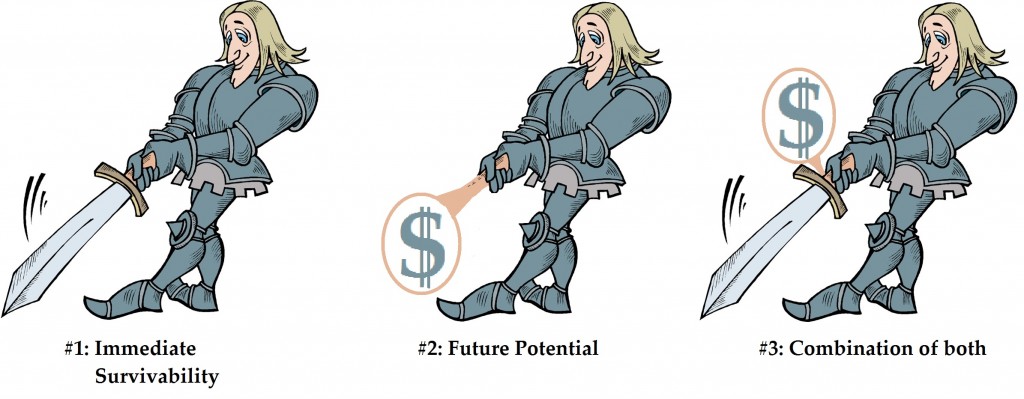 The above images illustrate the three critical types of change. In the basic simple case, each type is identical except that each has undergone some kind of mutation. The knight on the left can survive better than average because of his sword. The one in the middle has money that can, some day in the distant future, allow his posterity to finish building a castle and live there instead of in the little shack in which they now live. The knight on the right has a combination of the other two. The first two knights were very fortunate to have been given something of great value. The third had the very rare luck to received two great gifts at about the same time. A key concept is this: In a kingdom of countless trillions of knights, #3 is far less common than either #1 or #2. Since the money (that can only be used in a long-term payment to construct a castle) has no short term benefit to survivability, it adds nothing to the daily survival of that knight. In fact, a “baggage” principle plays a part in the Evolutionary Boundary, for it takes a little bit of energy and attention to carry the money around. But even without the baggage principle, #1 knights will multiply faster than #3 knights, by definitions and by common concepts in natural selection. This is because #1 sub-populations immediately begin outnumbering the #3 ones, and this disparity becomes greater in future generations. What about #2 sub-populations? The problem is similar: They compete poorly with #1.
The above images illustrate the three critical types of change. In the basic simple case, each type is identical except that each has undergone some kind of mutation. The knight on the left can survive better than average because of his sword. The one in the middle has money that can, some day in the distant future, allow his posterity to finish building a castle and live there instead of in the little shack in which they now live. The knight on the right has a combination of the other two. The first two knights were very fortunate to have been given something of great value. The third had the very rare luck to received two great gifts at about the same time. A key concept is this: In a kingdom of countless trillions of knights, #3 is far less common than either #1 or #2. Since the money (that can only be used in a long-term payment to construct a castle) has no short term benefit to survivability, it adds nothing to the daily survival of that knight. In fact, a “baggage” principle plays a part in the Evolutionary Boundary, for it takes a little bit of energy and attention to carry the money around. But even without the baggage principle, #1 knights will multiply faster than #3 knights, by definitions and by common concepts in natural selection. This is because #1 sub-populations immediately begin outnumbering the #3 ones, and this disparity becomes greater in future generations. What about #2 sub-populations? The problem is similar: They compete poorly with #1.
Survival of the fittest
Natural selection, applied to this, eventually results in extreme dominance of the #1 types in the overall population. Many near-extinction events may threaten accumulated #2 and #3 types with extinction. Because of high numbers of organisms of #1 types, they are the ones that survive the threats: They can avoid extinction much better. It may not seem obvious in the first generation, but each reproductive cycle increases the disparity: 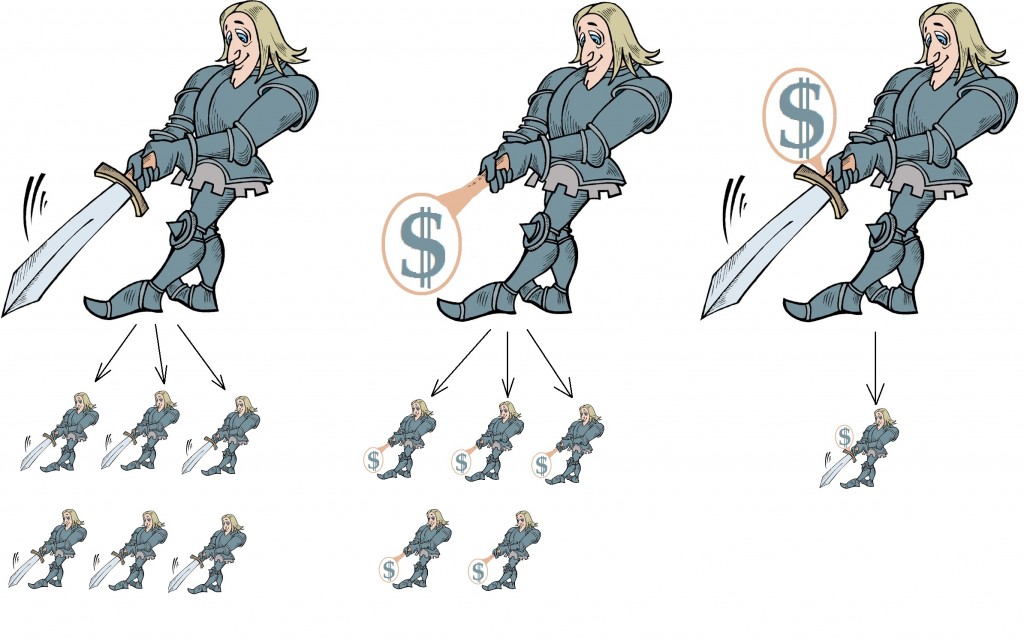 Why is #3 (on the right) shown to have so few descendants, compared with the other two? It is actually representing sub-populations, not an individual organism, in the three larger knights at the top of this image, and #3 has only a small fraction of parents, compared with the others. In other words, the large knight on the upper right represents a small population, compared with the other two large knights; the smaller images of the first-generation descendants represent crude approximations of actual number of descendants.
Why is #3 (on the right) shown to have so few descendants, compared with the other two? It is actually representing sub-populations, not an individual organism, in the three larger knights at the top of this image, and #3 has only a small fraction of parents, compared with the others. In other words, the large knight on the upper right represents a small population, compared with the other two large knights; the smaller images of the first-generation descendants represent crude approximations of actual number of descendants.
What About the Real World?
Does this mathematical simulation relate to real-world biology? Survival of the fittest (natural selection) and macro-evolutionary potential (or lack thereof) can be seen in more than just this simulation. Why should simple little organisms ever evolve into large complex organisms? Take a theoretical case: This planet is hit with a disaster so overwhelming that all human life is destroyed. What might be left? Smaller simpler organisms. Why? Small simple life survives better than large complex life. In other words, Darwin was completely wrong about small simple life gradually evolving into large complex life.
Take another case: As planetary travelers, we find a planet that appears capable of supporting life, but none lives there. We sprinkle the planet with countless trillions of microscopic organisms, then return after many millions of years of absence. What do we find? Not a sign of life. The non-living substances survive better than any life, so that’s what is left after all those millions of years of neglect: sand, rocks, water.
So how do living organisms survive on planet earth? They were put here, and preserved, by God, with all the care necessary for their continuation. I know that does not sound scientific, but it explains how such indescribable diversity of life exists on the earth.
What About Pterosaurs?
At about the time of Darwin, many scientists probably believed dinosaurs and pterosaurs were primitive creatures that became extinct long ago because they did not have the survival qualities needed to continue into the present. We now agree that great destructive forces caused many living things to die long ago, although a variety or origin philosophies and belief systems cause divergent opinions about when and why destruction occurred.
Let’s look a little at pterosaurs. What would we expect if all pterosaurs were put here by God, just a few thousand years ago? The Flood of Noah could have destroyed particular types, but the two basic general types could have been preserved when Noah’s family was saved with all the life that they had on the Ark.
What would we expect if all of the countless forms of pterosaurs lived on this earth many millions of years ago? Look at textbooks of Western biology and paleontology: Universal extinction of all their species is taken for granted. If one species survived in a remote little-explored tropical wilderness, that would be expected to be of only one type, most likely Pterodactyloid. What paleontologist would dream that both Rhamphorhynchoid and Pterodactyloid pterosaurs still live on most continents in the twenty-first century? So what kind of eyewitness reports do we have from around the world? Strange to tell, but both Pterodactyloid and Rhamphorhynchoid pterosaurs appear to live in various areas, although evidence points to many (if not all) of them being nocturnal. How different from what most Western paleontologists would guess could be possible!
###
.
Pterosaur Sighting in Grantsville, Utah
. . . Suddenly as I looked up at the night sky, the farm animals started up again and then I saw it. The ropen. . . . I was awestruck. I began to wonder what type of animal this was. But within minutes higher up in the sky I saw it again and appeared soaring above us and then vanished again.
.
Evolution, Religion, and Extinction of Pterosaurs
Some skeptics of living-pterosaur investigations (including searches for the ropen), well quite a few of the skeptics, have dismissed our work because they assume that our religious bias makes us incapable of objective scientific investigation. But those skeptics may have their own bias . . .
.
Ropen – a Modern Pterosaur
The third edition of the nonfiction book “Live Pterosaurs in America” proves this is not a mystery confined to remote tropical rain forests in Papua New Guinea. Ropens continue to shock eyewitnesses around the world, including many common persons in the United States of America.
.
###
.
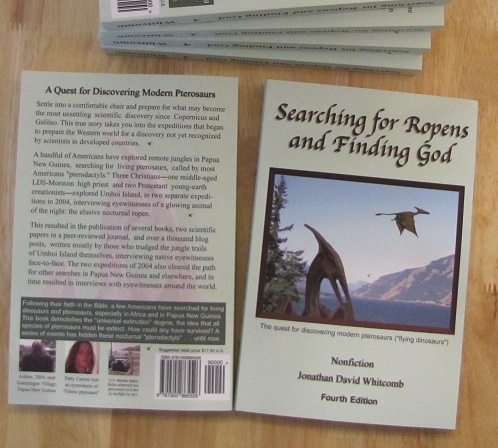
Third edition: Searching for Ropens and Finding God (nonfiction)
From the Introduction:
Expect references to the Biblical fiery flying serpent and the Flood of Noah. I added “finding God” to the title of the third edition to avoid offending someone wanting only cryptozoology, a reader who would be offended to find a little religion, however limited; it’s continued in this fourth edition: finding God.
.
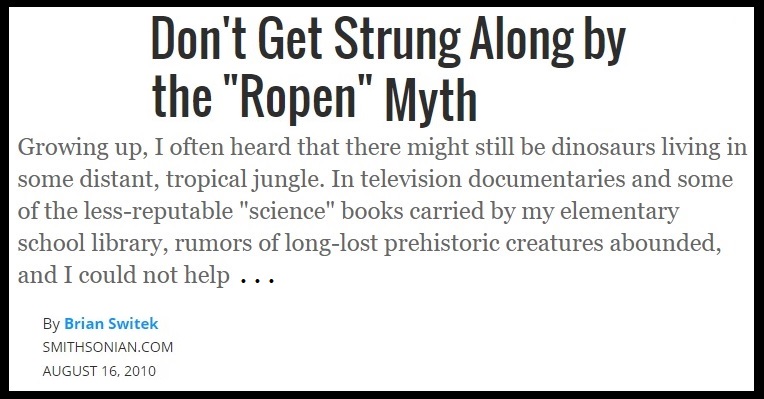



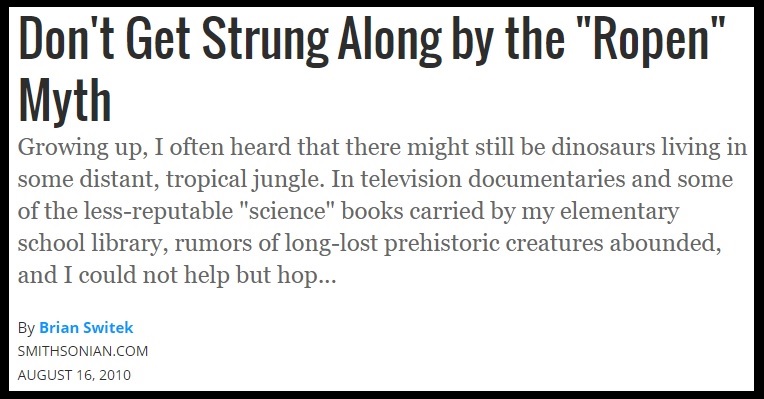
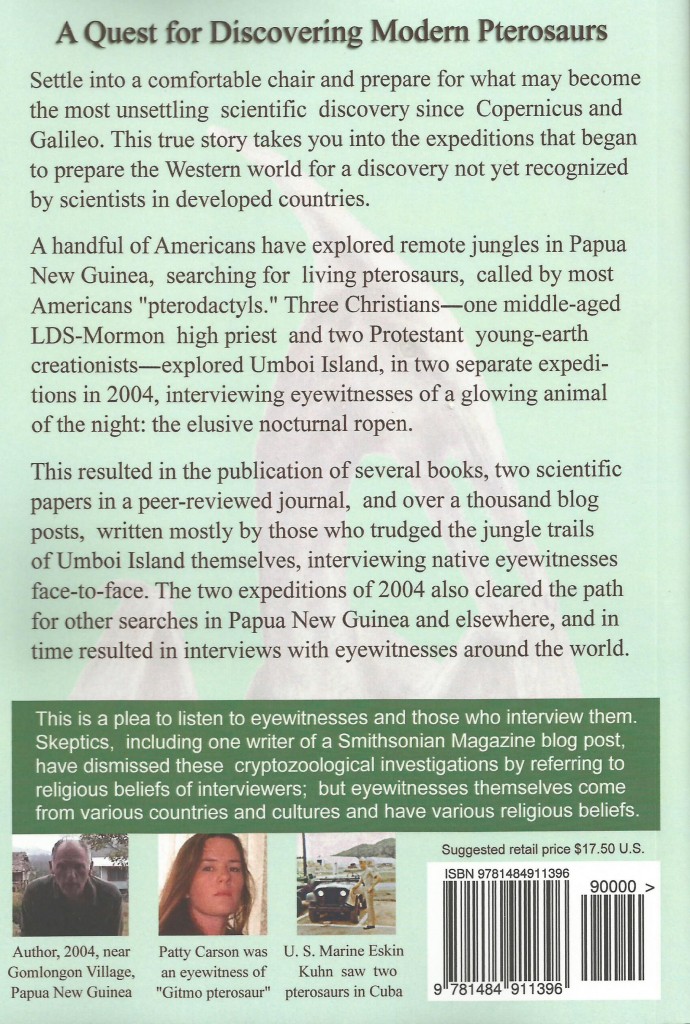
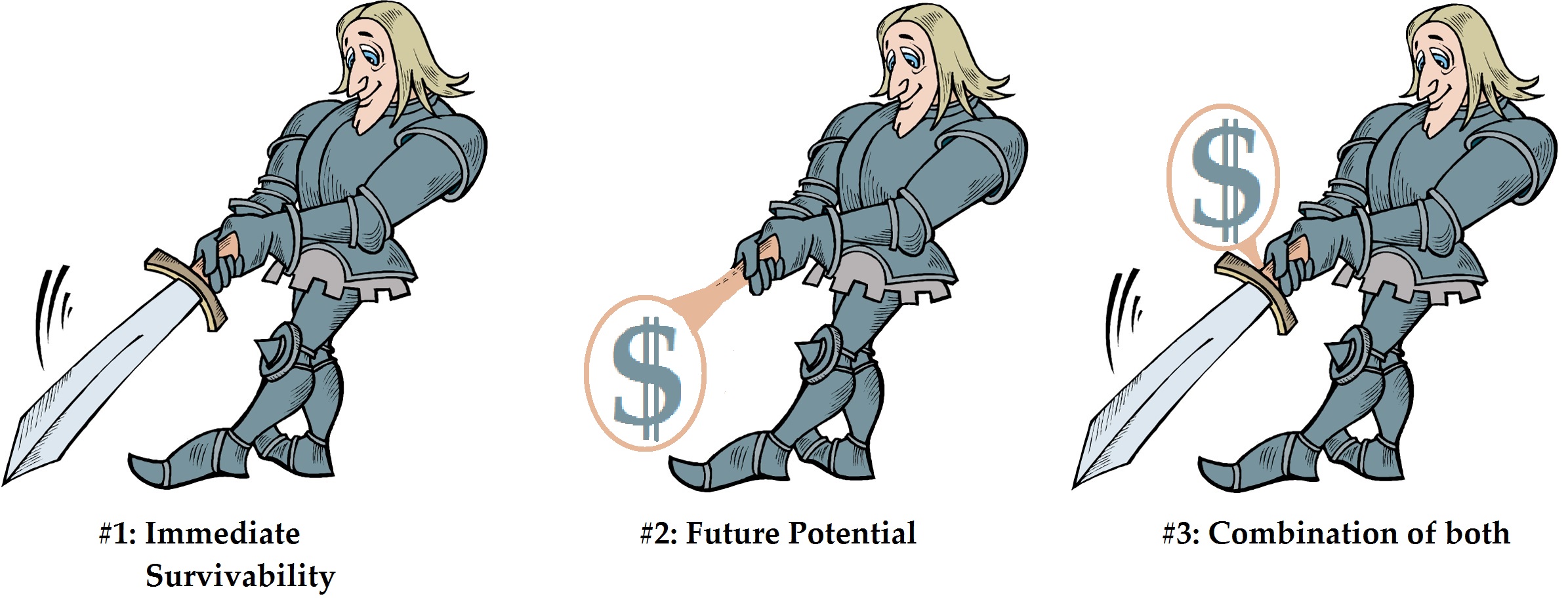

 Why is #3 (on the right) shown to have so few descendants, compared with the other two? It is actually representing sub-populations, not an individual organism, in the three larger knights at the top of this image, and #3 has only a small fraction of parents, compared with the others. In other words, the large knight on the upper right represents a small population, compared with the other two large knights; the smaller images of the first-generation descendants represent crude approximations of actual number of descendants.
Why is #3 (on the right) shown to have so few descendants, compared with the other two? It is actually representing sub-populations, not an individual organism, in the three larger knights at the top of this image, and #3 has only a small fraction of parents, compared with the others. In other words, the large knight on the upper right represents a small population, compared with the other two large knights; the smaller images of the first-generation descendants represent crude approximations of actual number of descendants.
